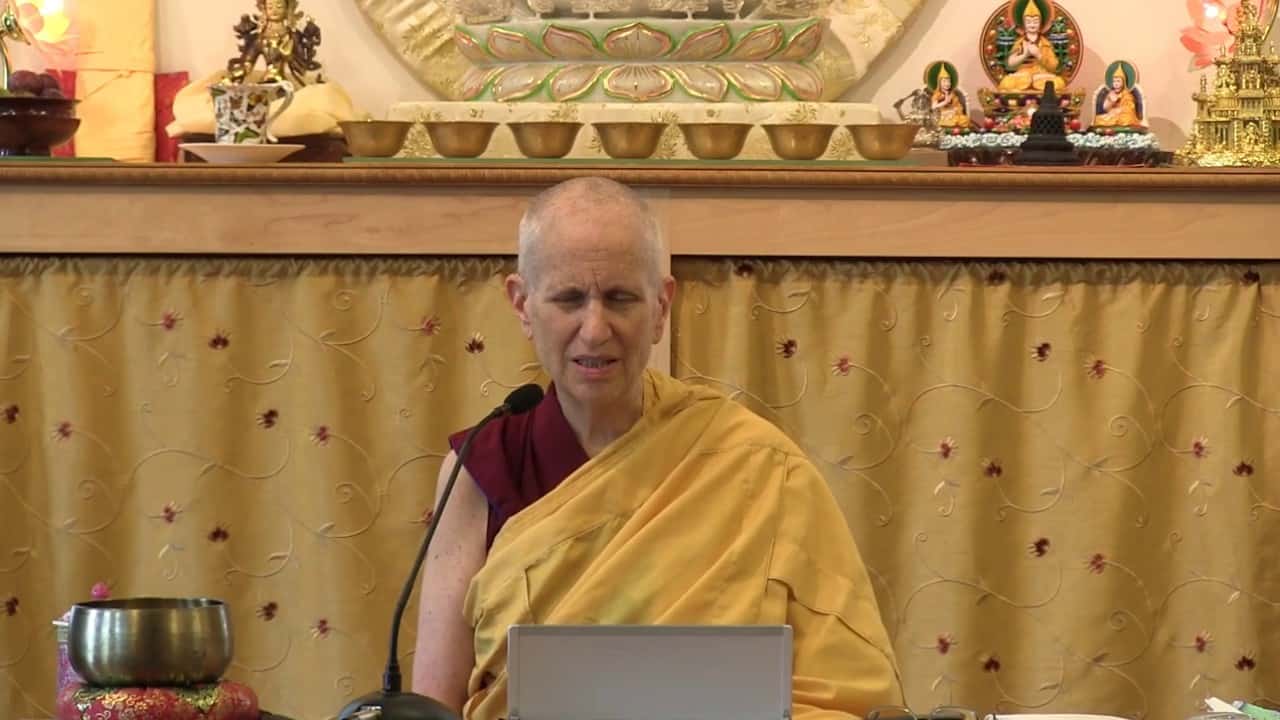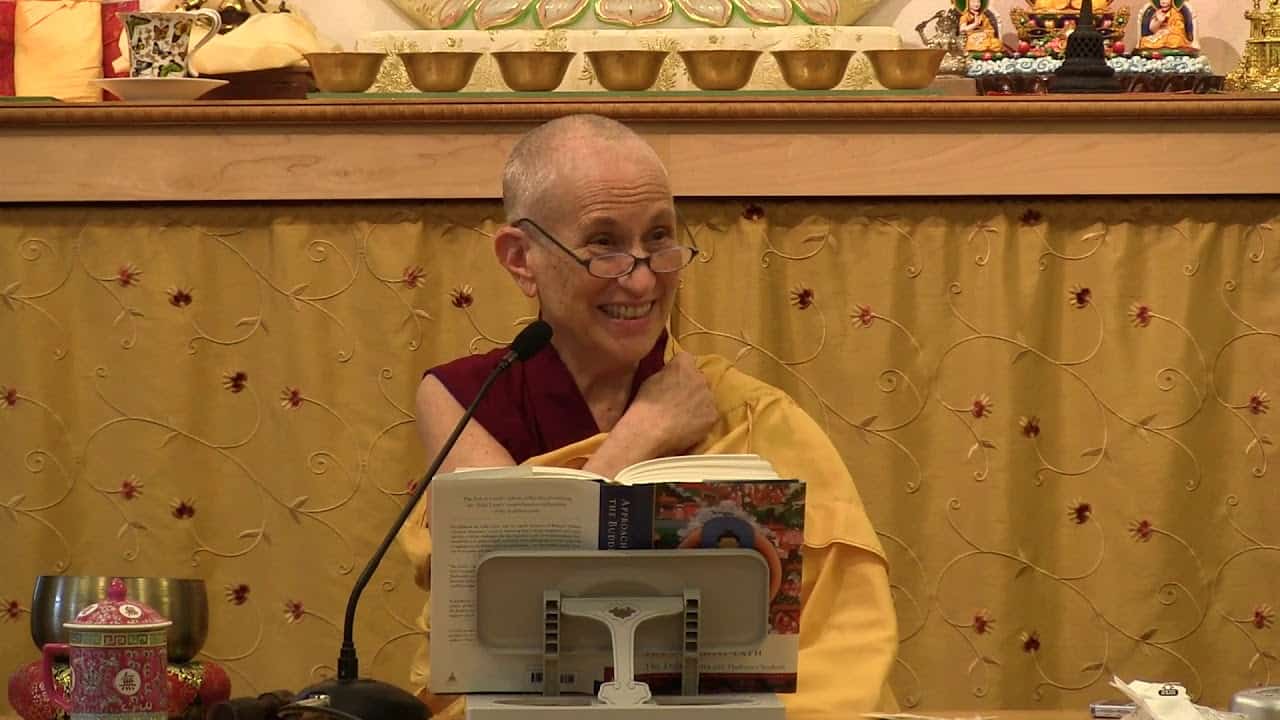Dismantling identities
Venerable Thubten Kunga explores the identities we are conditioned to grow up with and looks at how questioning and taking them apart opens up our potential for growth.
When we practice the Dharma, we seek to radically transform ourselves from an ordinary person with a mind filled with confusion, anger, and greed to an omniscient being with boundless love and compassion for all sentient beings who can lead them to a state everlasting peace and happiness.
Needless to say, this is a complex process that takes quite a long time.
But if you are sitting here today, you might have suspected that one way to speed along this transformation is to move to an environment where all the right conditions are in place to minimize afflicted mental states from arising while supporting the development of good qualities and wholesome behaviors.
And this is exactly what a monastic community is designed to do.
One thing that everyone who moves to the Abbey learns is that leaving the regular householder life to become a monastic requires a whole resocialization process that will affect every aspect of who you consider yourself to be.
I’m going to talk a little bit about this process today by focusing on how I’ve had to let go of some old identities.
Aside from learning all the different prayers, meditations, and practices, uncovering and deconstructing these identities has taken up a lot of my energy since stepping through the front door.
Buddhism teaches that every phenomenon lack an independent, separate, unique self and instead exists in dependence on causes, conditions, parts, and a mind that conceives and labels it.
The person we conceive of as our self, or “I,” is of course no exception to this reality.
The first step in the traditional meditation on emptiness is identifying the object of negation, which is the inherently existent “I.” But before we even get to that level of analysis, it’s helpful to examine all the conventional selves we carry around, sometimes completely unbeknownst to us.
I want to show you some images that really shaped who I thought I was while I was growing up, or more precisely who I thought I should be. These images will probably be familiar to you if you grew up in the United States or other Westernized countries.
This first image represents what I concluded a woman should look like, at least according to those in the fashion magazine industry. Blonde, white, thin, and large-breasted. I have never been any of these things and grew up with a lot of anger towards myself and my body for not being the ideal shape, size, or weight.
I basically took on the identity of “not beautiful” and am still working to dismantle this poor-quality view of myself that has drained me of the energy and confidence I need to make a positive difference in my life and the lives of others.
One way I’ve been loosening some of this unhealthy way of thinking is by doing a meditation that reduces attachment and identification with the body.
By mentally taking apart the body in meditation, we find that nowhere in that collection or the parts themselves is the “I” we hold onto so strongly.
We also see it’s rather ridiculous to measure the value of our lives by the color or texture of our hair, though this is exactly what advertising leads us to believe.
Ordaining also helps to shed the superficial identities based on appearance or physical characteristics because the first thing we do is to shave off our hair, throw out our perfume and make-up, and put on baggy, unstylish clothing that is the same as everyone else. It’s no longer really possible to define ourselves as sexual objects.
Just so the men in the room are not left out, here is an image of what we’re often told a man is supposed to look like.
There is another identity I’ve internalized that I’ve had to let go of moving here. It’s that of the smart and successful career woman. This woman is constantly advancing herself in social circles, always seeking new credentials and accomplishments, and looking for the next, better, higher paying job (believe it or not, the Career Services at my former place of employment told me that I should ALWAYS be searching for my next job even the day I am hired at another one). This person is ambitious, competitive, and believes fully in the myth of individual accomplishment.
Here’s the male version of that role to its fullest extent.
This attitude of ambitious greed and self-centeredness is completely at odds with the culture at the Abbey, which I am glad about because that attitude caused me a lot of misery during my short career.
In a community setting, everyone has to work together cooperatively, consider the needs of others, and make decisions collectively. No one is trying to advance themselves at the expense of others or get the biggest share, but rather are rather learning how to live in harmony with one another.
Then there is the identity of good family member, whether it be daughter, sister, mother, niece etc. They are accommodating, nurturing, and put their needs last. For women, this is often some kind of caretaker role. For men, it could be something like a breadwinner or provider role.
Here at the monastery we do not work for money, nor are we full-time caregivers or homemakers. We can’t act as heads of household and dictate our opinions and wishes on everyone else, as much as we’d like to.
There’s also the good student role, the good friend role, the good girlfriend role I’ve worked at dismantling.
We might even have a good citizen, good sports fan, or even the good religious practitioner role.
For each of these roles, we have standards regarding the ideal and are constantly measuring ourselves against this standard. Chances are, we are falling short, because ideals are just that – something rare and difficult to find in everyday life.
Now I’m not saying that there’s anything inherently bad with each of these roles, just that if we define ourselves solely in terms of these ideals and how we measure up, we will lose sight of the bigger picture and our potential.
As I’ve worked to shed these identities coming to live as a monastic, I’ve tried to avoid creating new roles and standards to lock myself into and judge myself against.
I have tried not to obsess over my hair getting too long – though here the shiny bald head is the most fashionable style.
I’ve had to accept that the folds of my robe will not line up around my waist as perfectly as I’d like.
I’ve had to avoid turning the holes in my socks into a status symbol representing the strength of my renunciation.
But more importantly, I’ve had to work on my attachment to praise from teachers and seniors and competitively comparing myself to peers.
I’ve seen the urge the build a new reputation as the nun who can do policy research, who plays the devil’s advocate in group discussions by asking uncomfortable questions, or who always brings in perspectives of other Buddhist traditions.
I’ve also seen my mind label myself as a friend to the people who smile and say nice words to me, a stranger to people who don’t provide me with enough praise, and an enemy to people I have difficulty relating to or communicating with.
So alongside dismantling old identities I brought with me, I’ve also had to try to avoid creating new ones based on the same afflicted ways of thinking.
So does this mean that we can’t have any identities at all? No, we actually need a stable conventional self in order to relate to others, practice the path, and plan our lives in a skillful way.
Conventional and ultimate reality are not contradictory, and we need to skillfully recondition our body and minds to act in accordance with reality.
So some new identities I’m trying to take on that I think could actually be helpful are:
- someone who is learning how to practice the Dharma,
- someone learning how to live in a group of people with completely different temperaments and backgrounds, and
- someone learning how to genuinely care about others’ wishes and needs
- and someone learning how to cultivate peace in a chaotic world
- I’m also starting to see myself as part of an ever-changing community, and a member of humanity and all sentient beings.
I think the key here is that these new identities are all open-ended and allow for ongoing growth and change.
And my hope that the flexibility of these identities will prevent me from creating new unrealistic expectations and allow me to grow in ways that I could not have foreseen.
Though the monastic lifestyle is very unique, everyone has to take on and take off different roles at different points in their lives, so I hope this sharing will help you do to so gracefully and with optimism and joy.
Venerable Thubten Kunga
Venerable Kunga grew up bi-culturally as the daughter of a Filipino immigrant in Alexandria, Virginia, just outside Washington, DC. She received a BA in Sociology from the University of Virginia and an MA from George Mason University in Public Administration before working for the U.S. State Department’s Bureau of Refugees, Population, and Migration for seven years. She also worked in a psychologist’s office and a community-building non-profit organization. Ven. Kunga met Buddhism in college during an anthropology course and knew it was the path she had been looking for, but did not begin seriously practicing until 2014. She was affiliated with the Insight Meditation Community of Washington and the Guyhasamaja FPMT center in Fairfax, VA. Realizing that the peace of mind experienced in meditation was the true happiness she was looking for, she traveled to Nepal in 2016 to teach English and took refuge at Kopan Monastery. Shortly thereafter she attended the Exploring Monastic Life retreat at Sravasti Abbey and felt she had found a new home, returning a few months later to stay as a long-term guest, followed by anagarika (trainee) ordination in July 2017 and novice ordination in May 2019.


